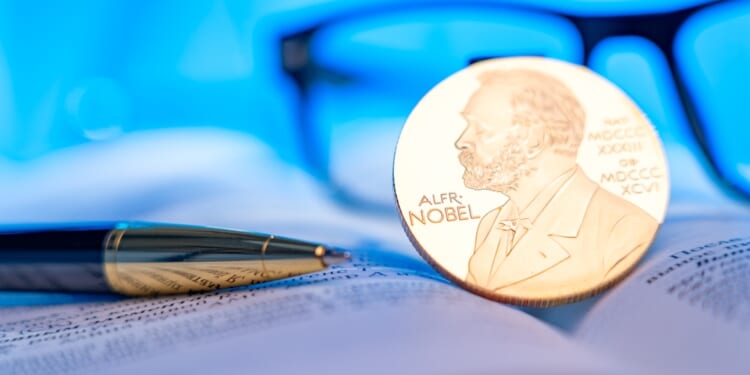The winners of the 2025 Nobel Prize in Economics underscore how innovation and openness fuel progress—offering lessons for the US–China AI race and the fragility of growth.
The 2025 Nobel Memorial Prize in Economic Sciences, awarded to Joel Mokyr, Philippe Aghion, and Peter Howitt, could not be more timely. Their research explains how innovation, openness, and “creative destruction” sustain long-term growth—an insight that speaks directly to the world’s defining competition between the United States and China over artificial intelligence (AI). As AI reshapes the global economy, the laureates’ theories offer both a roadmap and a warning: societies that embrace openness and manage disruption can prosper, while those that suppress experimentation or isolate themselves risk stagnation.
For most of human history, stagnation was normal. Mokyr showed that sustained growth began only when invention was joined with scientific understanding—when people learned not only that something worked, but why. In his seminal work A Culture of Growth, Mokyr traced this transformation to Europe’s Enlightenment: a culture open to debate, curiosity, and dissent. Aghion and Howitt, working from the legacy of Joseph Schumpeter, developed the modern theory of endogenous growth. Their model of creative destruction explained how new technologies continuously replace the old—an engine of renewal that generates both prosperity and disruption. Together, these economists redefined progress not as a steady climb, but as a perpetual cycle of creation and reinvention.
America’s Market-Driven Model—and Its Emerging Weaknesses
The United States remains the closest embodiment of this dynamic system. Its AI ecosystem thrives on entrepreneurial competition, venture capital, and academic-industry collaboration. Firms such as OpenAI, Anthropic, and NVIDIA exemplify creative destruction in action: each breakthrough model or chip generation makes the previous one obsolete, pushing the technological frontier forward. This self-sustaining churn is what Aghion and Howitt called endogenous growth, innovation arising from within through market incentives and intellectual freedom.
Yet creative destruction comes with costs. Every wave of innovation displaces workers, bankrupts firms, and provokes social resistance. Aghion has long emphasized that for innovation to remain politically sustainable, societies must cushion disruption through education, mobility, and social insurance, not through protectionism. America’s challenge is precisely here. Its AI revolution is unfolding amid widening inequality, eroding trust in institutions, and a polarized political climate that threatens long-term investment in research and education.
At the same time, the US advantage in openness—long its hallmark—is beginning to erode. Visa restrictions and geopolitical suspicion have discouraged foreign scientists. Regulatory fragmentation and data-privacy patchworks slow experimentation. Antitrust and content moderation battles between the government and big tech create uncertainty that discourages long-term innovation. Even America’s cultural openness, Mokyr’s essential ingredient for self-sustaining growth, is strained by disinformation and populist backlash. These internal frictions are reminders that creative destruction, without inclusive renewal, can turn inward and self-defeating.
China’s State-Led Innovation and Its Structural Limits
China’s AI model operates on very different principles. The government orchestrates massive investments, directs state-owned banks to finance “national champions” such as Alibaba, DeepSeek, Huawei, Baidu, and Tencent, and deploys AI strategically in surveillance, manufacturing, and military modernization. This state-led mobilization can generate impressive short-term gains—China leads in facial recognition, industrial robotics, and AI surveillance exports—but it is also inherently brittle.
Through Mokyr’s and Aghion’s lenses, China’s strengths reveal their limits. Mokyr emphasized that sustained innovation depends on a culture of openness and inquiry. A society that censors academic exchange or punishes dissent undermines the very “market for ideas” that drives cumulative discovery. Aghion and Howitt’s model highlights another vulnerability: when political or bureaucratic priorities shield incumbent firms, the destructive half of creative destruction is blunted. Without the freedom to fail, innovation cannot renew itself. As Aghion cautioned during the Nobel announcement, “Openness is a driver of growth… Anything that gets in the way of openness is an obstruction to growth.” His warning applies not only to tariffs and trade barriers but also to restrictions on speech, data, and competition.
China’s model thus faces a paradox. Its capacity for coordination gives it short-term speed, but its lack of intellectual openness may undermine its long-term adaptability. The result is what might be called “authoritarian dynamism”—rapid mobilization without sustained renewal. Creative destruction requires not just creativity but also the willingness to destroy, and that is precisely what China’s political structure inhibits.
Openness, Trade, and the Global Innovation System
The laureates’ insights arrive as the world drifts toward economic fragmentation. The Trump administration’s tariffs on imports and China’s curbs on rare-earth exports illustrate how protectionism has reemerged as a central feature of global politics. Aghion described such trends as “dark clouds” over the global economy. Trade and migration are not just mechanisms for commerce—they are the arteries of innovation, transmitting ideas, skills, and knowledge spillovers that fuel endogenous growth.
Mokyr’s historical analysis reinforces the point. Europe’s industrial takeoff depended on transnational intellectual networks that allowed engineers, inventors, and scientists to build on one another’s work. Fragmenting the global AI ecosystem into competing blocs—an American and a Chinese digital sphere—risks reversing that historic achievement. Instead of a shared global innovation frontier, the world could face a slower, duplicated, and less efficient technological evolution.
Yet the laureates would not advocate pure laissez-faire. Aghion’s more recent research on “directed technological change”recognizes that innovation must be steered toward public goods, such as green technology and AI safety. The task is not to halt creative destruction but to channel it. That requires intelligent regulation—policies that encourage competition, protect fairness, and align market incentives with long-term sustainability.
The AI Race as Modern Creative Destruction
Artificial intelligence itself is the ultimate expression of creative destruction. Each leap in model architecture renders earlier systems obsolete while enabling new industries—from automated medicine to autonomous logistics. The US–China AI race magnifies this cycle on a geopolitical scale: each side’s progress accelerates the other’s. This competition, if managed within open frameworks, can raise the global rate of innovation. But if it devolves into secrecy, data hoarding, and a heated technological war driven by hyper techno-nationalism, it could instead slow the pace of collective progress. Mokyr would likely view this as a regression toward pre-Enlightenment stagnation—where fear and control eclipse curiosity and exchange.
America’s Edge and the Fragility of Openness
Despite its imperfections, America retains structural advantages rooted in institutional pluralism. Its research universities, transparent legal system, and tradition of free inquiry form what Mokyr called a “Republic of Letters” adapted for the digital age. Immigration continues to feed its innovation ecosystem, and the interplay between government, academia, and private enterprise sustains a uniquely fertile environment for idea generation.
But this edge is fragile. The United States must guard against the sclerosis that Aghion warns can follow excessive concentration of power in dominant tech platforms. Fair competition policies, equitable access to AI infrastructure, and support for independent research are crucial to keep innovation decentralized and dynamic. Meanwhile, ensuring social legitimacy—by addressing inequality, algorithmic bias, and climate impacts—is essential to maintaining public trust in progress itself.
Aghion’s advocacy of green innovation also points toward the next frontier. AI’s enormous energy demands make sustainability not just a moral issue but a growth imperative. The United States should lead a new wave of clean-tech creative destruction—replacing carbon-intensive systems with intelligent efficiency. Innovation aligned with environmental responsibility, the laureates would argue, is the surest path to sustained prosperity.
Sustaining Growth in the AI Age
If Mokyr, Aghion, and Howitt were advising policymakers today, their message would be clear: openness and fairness are not luxuries—they are the foundations of innovation. Tariffs, censorship, and monopolistic power all undermine the feedback loops that make growth self-reinforcing. Policymakers must therefore preserve openness to ideas, trade, and people; protect competition while cushioning its human costs; and direct innovation toward broad social benefit.
The United States, with its pluralism and self-correcting institutions, remains better positioned to follow these principles. China’s centralized control may yield rapid advances, but without intellectual freedom, its growth engine risks exhaustion. As Aghion reminded the world, openness is the key to growth; as Mokyr would add, every revolution in technology begins with a revolution in ideas.
The 2025 Nobel Prize thus offers both celebration and caution. It reminds us that economic progress is not guaranteed but contingent on courage, curiosity, and the freedom to change course. Artificial intelligence, like the steam engine before it, can lift humanity to new heights or plunge it into rivalry and control. The outcome will depend on whether societies choose openness over fear, creation over protection, and knowledge over conformity.
About the Authors: Jianli Yang and Jamie Daves
Dr. Jianli Yang is a Research Fellow at the Kennedy School of Government at Harvard University. He is the Founder and President of Citizen Power Initiatives for China and author of For Us, The Living: A Journey to Shine the Light on Truth and It’s Time for a Values-Based “Economic NATO.”
Jamie Daves is the managing director of the Governing Board of the Institute for New Economic Thinking. He is also a Venture Partner at Lifeforce Capital and serves as a Senior Advisor at Smart Health Network.
Image: AntonSAN/shutterstock
















